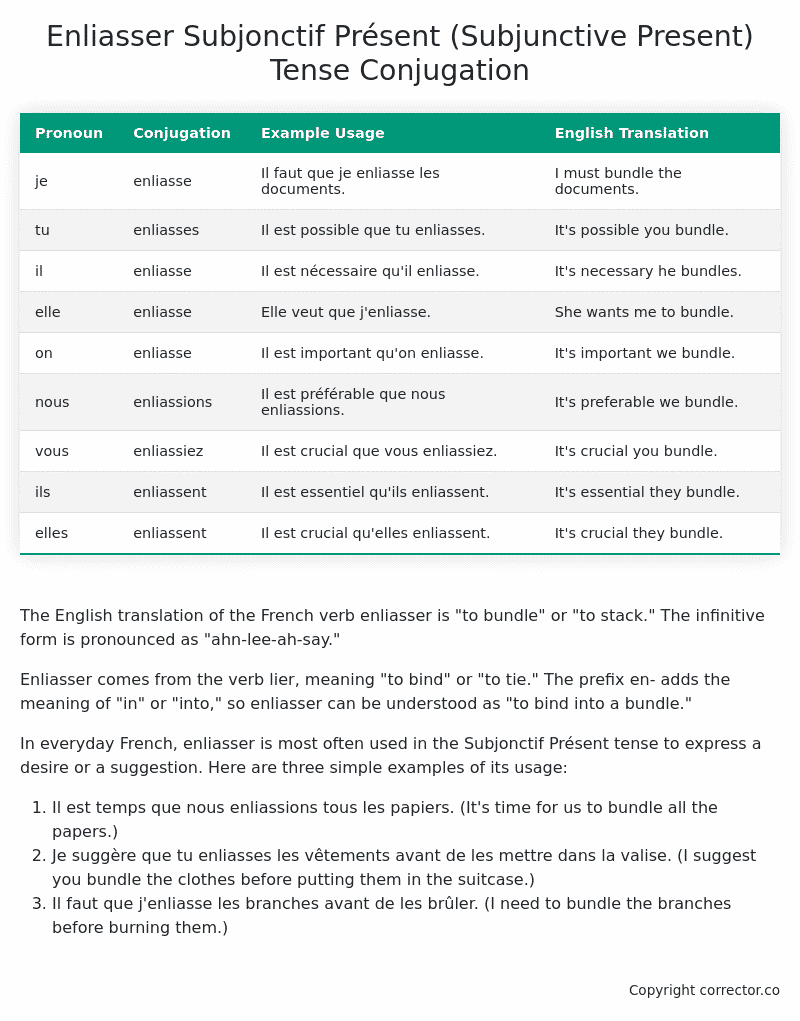Subjonctif Présent (Subjunctive Present) Tense Conjugation of the French Verb enliasser
Introduction to the verb enliasser
The English translation of the French verb enliasser is “to bundle” or “to stack.” The infinitive form is pronounced as “ahn-lee-ah-say.”
Enliasser comes from the verb lier, meaning “to bind” or “to tie.” The prefix en- adds the meaning of “in” or “into,” so enliasser can be understood as “to bind into a bundle.”
In everyday French, enliasser is most often used in the Subjonctif Présent tense to express a desire or a suggestion. Here are three simple examples of its usage:
- Il est temps que nous enliassions tous les papiers. (It’s time for us to bundle all the papers.)
- Je suggère que tu enliasses les vêtements avant de les mettre dans la valise. (I suggest you bundle the clothes before putting them in the suitcase.)
- Il faut que j’enliasse les branches avant de les brûler. (I need to bundle the branches before burning them.)
Table of the Subjonctif Présent (Subjunctive Present) Tense Conjugation of enliasser
| Pronoun | Conjugation | Example Usage | English Translation |
|---|---|---|---|
| je | enliasse | Il faut que je enliasse les documents. | I must bundle the documents. |
| tu | enliasses | Il est possible que tu enliasses. | It’s possible you bundle. |
| il | enliasse | Il est nécessaire qu’il enliasse. | It’s necessary he bundles. |
| elle | enliasse | Elle veut que j’enliasse. | She wants me to bundle. |
| on | enliasse | Il est important qu’on enliasse. | It’s important we bundle. |
| nous | enliassions | Il est préférable que nous enliassions. | It’s preferable we bundle. |
| vous | enliassiez | Il est crucial que vous enliassiez. | It’s crucial you bundle. |
| ils | enliassent | Il est essentiel qu’ils enliassent. | It’s essential they bundle. |
| elles | enliassent | Il est crucial qu’elles enliassent. | It’s crucial they bundle. |
Other Conjugations for Enliasser.
Le Present (Present Tense) Conjugation of the French Verb enliasser
Imparfait (Imperfect) Tense Conjugation of the French Verb enliasser
Passé Simple (Simple Past) Tense Conjugation of the French Verb enliasser
Passé Composé (Present Perfect) Tense Conjugation of the French Verb enliasser
Futur Simple (Simple Future) Tense Conjugation of the French Verb enliasser
Futur Proche (Near Future) Tense Conjugation of the French Verb enliasser
Plus-que-parfait (Pluperfect) Tense Conjugation of the French Verb enliasser
Passé Antérieur (Past Anterior) Tense Conjugation of the French Verb enliasser
Futur Antérieur (Future Anterior) Tense Conjugation of the French Verb enliasser
Subjonctif Présent (Subjunctive Present) Tense Conjugation of the French Verb enliasser (this article)
Subjonctif Passé (Subjunctive Past) Tense Conjugation of the French Verb enliasser
Subjonctif Imparfait (Subjunctive Imperfect) Tense Conjugation of the French Verb enliasser
Subjonctif Plus-que-parfait (Subjunctive Pluperfect) Tense Conjugation of the French Verb enliasser
Conditionnel Présent (Conditional Present) Tense Conjugation of the French Verb enliasser
Conditionnel Passé (Conditional Past) Tense Conjugation of the French Verb enliasser
L’impératif Présent (Imperative Present) Tense Conjugation of the French Verb enliasser
L’infinitif Présent (Infinitive Present) Tense Conjugation of the French Verb enliasser
Struggling with French verbs or the language in general? Why not use our free French Grammar Checker – no registration required!
Get a FREE Download Study Sheet of this Conjugation 🔥
Simply right click the image below, click “save image” and get your free reference for the enliasser Subjonctif Présent tense conjugation!

Enliasser – About the French Subjonctif Présent (Subjunctive Present) Tense
Formation of the Subjonctif Présent
Common Everyday Usage Patterns
Interactions with Other Tenses
Summary
I hope you enjoyed this article on the verb enliasser. Still in a learning mood? Check out another TOTALLY random French verb conjugation!


